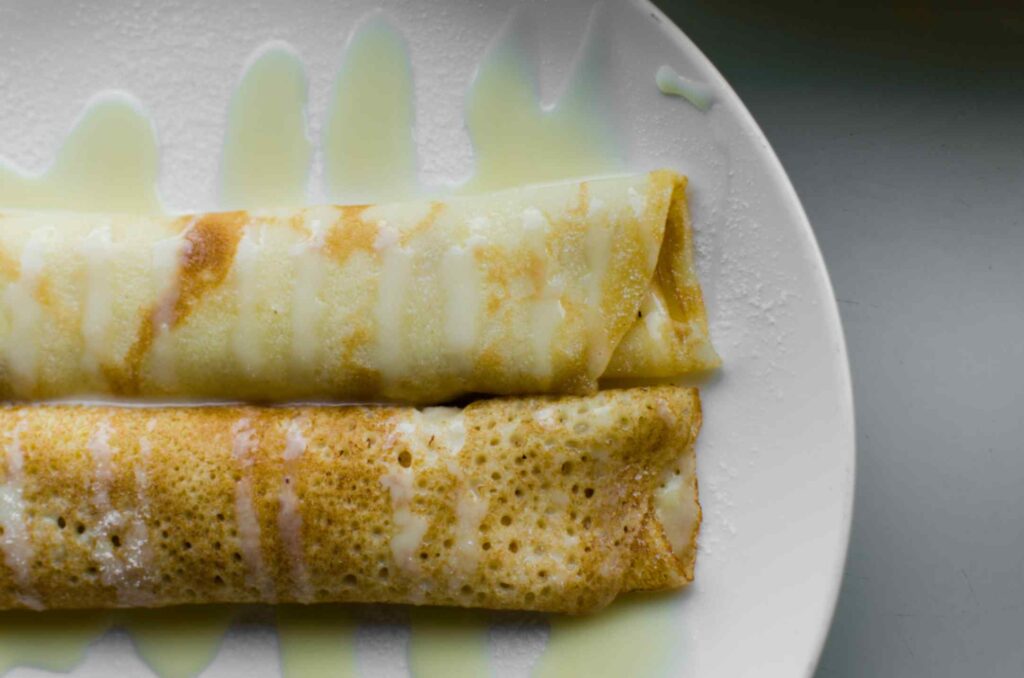Bengal has been a hub for sweetmeats for ages. You know what, in ancient Bengal which was undivided then, no cottage cheese had been used in making sweets. It was the Portuguese people who introduced cottage cheese (chhana) to Bengali cuisine in the 19th century. Before that, there was a time when other indigenous ingredients were being used, like coconut and milk nicely teamed with jaggery or misri (the raw sugar) to make sweets. Patishapta pitha belongs to that time period.
The trickiest part of making this amazingly tasted dish is making its base batter. You need to stick to its basic measurements. Initially, if you find it difficult to make the perfect batter, no worries, trust the process, you can achieve this with a little bit of practice.
Let’s see how you too can prepare it.
Ingredients:
For crepes:
Rice flour – 2 Cups
Flour – 1 Cup
Semolina – ½ Cup
Salt – a pinch
Powdered sugar – ½ Cup
Milk – 700 ml
For stuffing:
Stuffing 1
Milk – 1 Liter
Milk powder – ¾ Cup
Jaggery/Sugar – To taste
Stuffing 2
Coconut – 1 No. (scraped, roughly around 500 g)
Jaggery – 300 g
Sugar – 75 g
Procedure:
For crepe:
Take a large bowl where you may prepare the crepe batter freely. Put rice flour, flour, semolina, salt, and powdered sugar into it.
Give it a good mix.
Now add milk little by little turning it into a smooth batter. The batter should have running consistency but it should not be too watery. A watery batter makes the crepe too much thin making it brittle.
Lid it and keep it aside for at least 1 hour. This resting time gives the semolina and rice flour to soak properly.
Whisk a bit before using it. Just trust the process and follow the quantity. Your crepe will be perfect.
For the stuffing:
Stuffing 1
Boil the milk on a high flame.
Add the milk powder. Keep stirring continuously for 15 – 20 minutes.
Check whether the milk has a creamy consistency or not. As soon it reaches the right creamy consistency add the jaggery/sugar.
It will get a bit loose as soon as you add the sweeter this will release water. No worries. Stir it continuously on high flame. The right consistency of the stuffing will return.
Transfer it to a plate and let it cool down.
Stuffing 2
Take a wok where you want to make the stuffing (Paak) for your Patishapta.
Put coconut, jaggery, and sugar in it. Mix it well with your hands before you turn on the flame.
Now Set it on fire.
Stir thoroughly.
When the sugar and jaggery start caramelizing, cover it with a lid.
Cook it on medium to low flame.
Remove the lid after 2 – 3 minutes. Then again stir it. The repetition of the process will allow the coconut to take a bright brown color and the sugar will be caramelized nicely. Continue the process until it takes a nice binding shape.
Turn off the flame.
Keep it covered so that it doesn’t get hard.
Prepare the crepe:
Take a nonstick pan (I prefer using a cast iron skillet). Grease it with oil.
Now spread the batter with the help of a ladle as a round flat bread (Roti). Wait for half a minute or less.
As soon it changes the surface color a little bit and you will feel that the surface has dried, put some stuffing at one end of the crepe.
Now roll it.
Leave for some time if you want to make it more brown.
Your Patishapta Pitha is ready. Repeat the process to make another one.
Serve.
Nutritional Value of Patishapta Pitha per serving with coconut stuffing:
| Calorie | 812 Cal (41% of the Daily Value) |
| Protein | 8.7 g (16% of the Daily Value) |
| Carbohydrates | 65.6 g (22% of the Daily Value) |
| Fiber | 0.2 g (1% of the Daily Value) |
| Fat | 55.3 g (84% of the Daily Value) |
| Cholesterol | 12 mg (3% of the Daily Value) |
| Vitamin A | 582.5 mcg (12% of the Daily Value) |
| Thiamine | 0.1 mg (10% of the Daily Value) |
| Ribooflavin | 0.1 mg (9% of the Daily Value) |
| Niacin | 1.3 mg (11% of the Daily Value) |
| Vitamin C | 0.8 mg (2% of the Daily Value) |
| Vitamin E | 1.1 mg (7% of the Daily Value) |
| Folic Acid | 4.2 mcg (2% of the Daily Value) |
| Calcium | 169 mg (28% of the Daily Value) |
| Iron | 1.5 mg (7% of the Daily Value) |
| Magnesium | 41.2 mg (12% of the Daily Value) |
| Phosphorous | 158 mg (26% of the Daily Value) |
| Sodium | 18.9 mg (1% of the Daily Value) |
| Potassium | 132.5 mg (3% of the Daily Value) |
| Zinc | 0.5 mg (5% of the Daily Value) |
Percentage of Daily Value is based on a 2000-calorie diet.
Conclusion:
Though Patishapta Pitha is a delicacy to be cherished during winter, but who said you can’t have it in any season? If you are not using date jaggery or Nolen gur, which is available during winter only, you may try it anytime in your kitchen.
Just go for it.
Enjoy!
Read other Recipes here.

